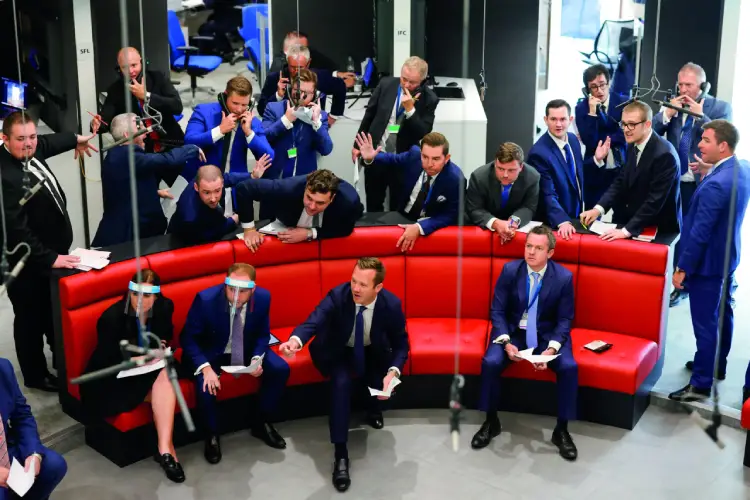
As the London Metal Exchange faces lawsuits filed by US hedge fund Elliott Management and others, Robert Jackman looks into its controversial decision to suspend nickel trading earlier this year.
Amid the high-tech trading floors of the City, the London Metal Exchange has long been an outlier: proudly standing as the last exchange in Europe where trades are conducted using the kind of hand and verbal signals banished elsewhere by the arrival of computers. Situated just a stone’s throw from the Bank of England, its trades account for more than 3.5 billion tonnes of metals each year.
In March, however, the LME became famous for another reason, when a ferocious surge in the price of nickel led the exchange not just to suspend trading but to cancel $4 billion’s worth of trades already on its books. Within hours, the decision had made headlines around the world, throwing the LME into its biggest crisis in decades.
Should it have seen it coming? Market watchers tell Spear’s the warning signs were evident well beforehand. After Russia’s invasion of Ukraine had aggravated market volatility, rumours began to circulate of a large bet against the price of nickel – which would eventually trigger an explosive short squeeze (where prices are driven up by a rush of short sellers clamouring to cover their positions) and the frantic scenes pictured on these pages.
‘That they didn’t see it coming raises serious questions of the kind of market surveillance the LME is doing,’ says Malcolm Freeman, a seasoned trader and chief executive of Kingdom Futures. Had they spotted the patterns, he adds, management could have suspended trading earlier and asked traders to up their margins. Instead, the LME’s fate was sealed when it opened as normal on Monday 7 March (the day before the big squeeze), allowing the price to spike by 30 per cent.
In the early hours of the next morning, nickel went stratospheric, as a 250 per cent rise turned its trading graph into a straight vertical line. At 8:15am, just as much of the financial district’s workforce was beginning its daily grind, the LME took the decision to pull the plug on nickel. Its market remained closed for more than a week afterwards, leaving traders in the dark as to what would happen next.
So what went wrong? In public statements made in the days after the incident, the London Metal Exchange blamed the short squeeze on its lack of oversight over the much larger OTC (over-the-counter) markets, which operate (usually via investment banks) in parallel to its exchange. Its chief executive, Matthew Chamberlain, has said the lion’s share of the gargantuan short position that triggered the squeeze (placed by the Chinese steel giant Tsingshan) had been placed OTC – and thus off the LME’s radar.
Chamberlain’s explanation hasn’t convinced everyone. US hedge fund Elliott Management and market maker Janes Street have filed law suits. The incident will also be subject to formal scrutiny from the LME’s two main regulators, the Bank of England and the FCA. Meanwhile, an internal LME review will focus on governance reforms to restore market confidence – which some pre- dict will prove easier said than done. ‘The damage is off the scale here,’ says veteran metal trader Geoffrey Sambrook.
The London Metal Exchange continues to insist that the steps were taken ‘in the interests of the market as a whole’ – though what that means has been left open to interpretation. ‘I think several of their members would have been rendered in- solvent if the trades had stood,’ says Freeman. Others say the losses could have over- whelmed the LME’s internal clearing house – the reserve of cash it keeps aside to settle trades – thus risking its own solvency.
For all the controversy, though, the Lodnon Metal Exchange isn’t the first exchange in recent memory to find itself under fire for restricting trades. At the height of the ‘meme stock’ frenzy of early 2021, the US-based digital broker Robinhood drew flak when it blocked users from taking new positions in GameStop – the beleaguered US retailer whose share price had gone into overdrive – for fear that the surge in trades would push the platform beyond its own margin requirements with its industry clearing house.
While Robinhood has always insisted it had no choice but to restrict trades, much of its millennial user base felt otherwise. Users of WallStreetBets (the Reddit forum synonymous with the meme stocks craze and known for its hostility to the Wall Street establishment) had their own theory: that Robinhood had acted at the behest of a partner company that stood to lose out from GameStop’s rise. A class action alleging such a plot was defeat- ed last November, with a US district judge rendering the claim implausible.
For all their differences, the London Metal Exchange and Robinhood controversies have one central factor in common. Both involved exchanges coming unstuck after rocketing prices dwarfed the available margin – the fractional deposit put down by traders as security against a default. Backed into such a corner, the LME and Robinhood have shown how markets prioritise their own survival.
Could there be a better way of doing things? In March, US regulators opened a consultation on a proposal to use blockchain technology – peer-to-peer ledger systems whose supposed infallibility underpins the cryptocurrency infrastructure – to perform the functions typically entrusted to brokers. In theory, this would create a fully automated exchange, removing the ability of institutions to rewrite the rules in their favour.
The plan has been devised by blockchain evangelist (and crypto-billionaire) Sam Bankman-Fried, who says his blockchain- based exchange would prompt traders when they need to increase their margin. Once that notice period has expired, traders still exceeding their margin requirements can either see their positions automatically closed in 10 per cent increments or borrow the difference from other members.
Will it work? Perhaps unsurprisingly, the established players aren’t sold. In a letter to the regulator, FIA (the representative organisation for the international derivatives and options trading industry) has warned that an automated process could exacerbate volatility and increase the influence of bad actors.
More prosaically, it would leave markets powerless against ‘fat finger’ mistakes caused by traders’ human error.

Such bloopers already have the potential to cause market panics. In May, an error from a Citigroup trader sent Swedish stocks plunging 8 per cent in ten minutes. But where human error is proven, brokers can cancel affected trades, ensuring participants aren’t left paying the bill for others’ mistakes. In an automated system, though, such mistakes would be much harder to correct and may trigger a much wider sell-off.
The vanguard of crypto-utopians may seem a world away from the old-world practices of the London Metal Exchange, yet both raise fundamental questions about the nature of markets. Do they exist purely to execute the positions of speculators, or do they have discretion (or even responsibility) to protect their own stability? And what happens when that mandate clashes with the interests of others within the market?
With enough on its plate already, the LME could be forgiven for ducking philosophical questions. Yet its story has made them more than mere hypotheticals – and thus more difficult to ignore.
In the trading pit of the London Metal Exchange, traders say the nickel market has returned to something resembling normality. However, the full extent of the fall-out from its implosion may not be clear for some time to come.
Image Credits: Jason Alden, Getty; Lam Yik/Bloomberg via Getty
Spear’s Magazine presents Spear’s 500 Live on 7 September. Find more information on NSMG.live.






